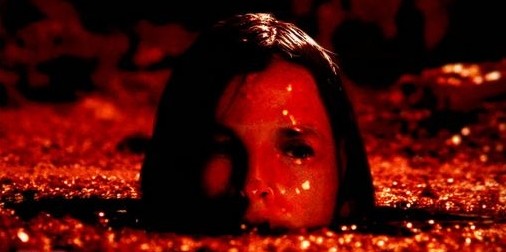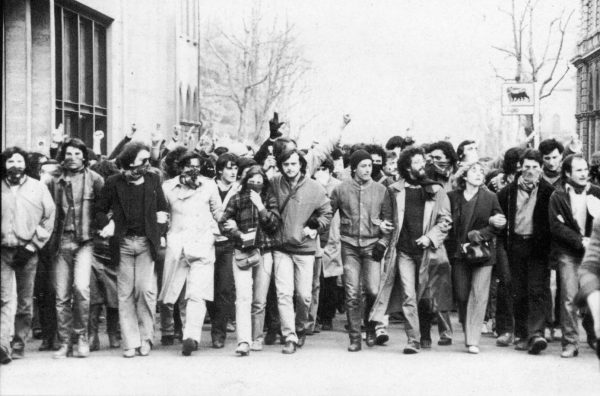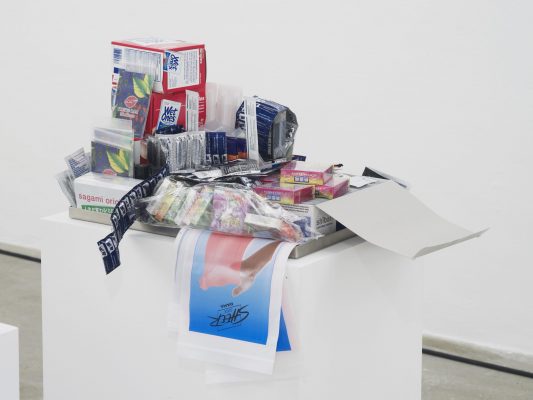In Neil Marshall’s 2005 horror film The Descent, a group of women go spelunking and become trapped deep underground in a winding, disorienting cave system. The women are athletic and trained, their storylines and inter-personal relationships tense and toxic, complicated by hidden affairs and neglected friendships. The film is terrifying: the downfall of the group — and the framework for the whole, horrifying sequence of events that unfold — rests solely on one woman’s inflated ego and her brittle ambition to be the first to map and claim this as yet unchartered subterranean cave system. They begin to act brutally towards each other. Yet it makes a nice, albeit rare, change to see women acting horrendously, instead of the usual male-on-female violence that proliferates horror films and real life. The film is a portal to a nihilistic hellscape dominated by amorphous yet vaguely humanoid flesh-eating creatures who begin to hunt the trapped women indiscriminately by following their voices. Foregrounding both female strength and flaws, the subterranean not only becomes a home to violence, but seems to give permission for violence to be freely practiced. The movement of the film speaks to the familiar lines from Dante, seen on arrival at the gates of hell:
Through me you go to the grief-wracked city.
Through me to everlasting pain you go.
Through me you go and pass among lost souls.
Justice inspired my exalted Creator.
I am a creature of the Holiest Power,
of Wisdom in the Highest and of Primal Love.
Nothing till I was made was made, only
eternal beings. And I endure eternally.
Surrender as you enter every hope you have.
Jenny George’s debut book of poems The Dream of Reason submerges the reader in subterranea from its first few lines, finding a linguistic parallel for the technique used in The Descent to induce a sense of horror from the start. Just as the women in The Descent drop down one by one in darkness through caves, George pulls us down below ground level from the collection’s opening poem, ‘The Origins of Violence’:
There is a hole
in the hole is everything
people will do
to each other.
The hole goes down and down.
It has many rooms
like graves and like graves
they are all connected.
From this point on, poems and reader exist in a territory that is underground, within a landscape that is violent and strange. The book’s darkness borders on the occult; a bat crawls around ‘like a goblin’, children die, pigs are slaughtered en masse (‘The pigs hang in rows like pink overcoats. / Their slaughter is fresh, a rosy blush’). The Dream of Reason is a kind of lyric nocturne; George speaks of the things that emerge when the diurnal gives way, or perhaps just when the light is shut out: the kind of worst-case scenario thinking specific to the night, saved up through the day for when there’s nothing else to think about. The contents of the book read like a grimoire of nightmares, the poem titles like those of books you’d find lined up in an esoteric bookshop: ‘Death of a child’, ‘Encyclopedia of the Dead’, ‘Sword-Swallower’, ‘Sonnet for Lost Teeth’, ‘Talisman’. The book’s title is taken from a Goya etching: ‘El sueño de la razón produce monstruos’, the epigraph telling us that there are two well-known English translations from the Spanish, the more common being ‘The sleep of reason produces monsters’. George takes her title from the other: ‘The dream of reason produces monsters’.
This nocturnal rooting reminds me of one of my favourite lines in poetry, from Lorca’s ‘Moon Poems’, (translated from the Spanish by Alan S. Trueblood): ‘At the rise of the moon, / bells fade out, / and impassable paths / appear.’ Both George and Lorca foreground the night as a kind of antechamber for unruly events, supernatural occurrences, monsters and the cessation of familiarity, where daytime logic is inverted, where anything could happen. Lorca’s paradoxical impassable paths always give me pause; surely what makes a path a path is its inherent passability? If a path is built so that a route may exist through an otherwise impassable landscape, an impassable path lacks a certain kind of reason, like how the night can feel unreasonable. Lorca’s paths stay with me at each turn in my own life, a little poetic mantra for accepting the unreasonableness of things.
Reason, its contradictions, its histories and its philosophical complexities are the through-force of George’s book and provide the context for her disassembling poetry. She deploys the tropes of horror as an affront to reason – as a way to question how to manage expectations of the unreasonable things in life, how they are dealt with. In the palindrome poem ‘The Traveling Line’, an exceptionally graceful and curt journey through the violence of intensive animal agriculture, repeated refrains remind us how a line can hold multiple layers of meaning:
[…] The pigs become a traveling line.
Moving up the ramp the fever rises.
There is the clank of metal.
They hold still inside confusion.
A current passes through their bodies.
Blood comes from their mouths in strings.
By the ankles they are swiftly inverted.
Blood comes through their mouths in strings.
A current passes through their bodies.
They hold still inside confusion.
There is the clank of metal.
Moving up the ramp the fever rises.
The pigs become a traveling line.
The Cartesian theory that animals are automata – ‘Bête Machine’ – that they cannot feel or reason, and should be treated as such, like machines, is the precursor to our mechanical age of animal agriculture. It is unarguably cruel, yet still holds in the contemporary treatment of the animals we eat. George’s slow and methodical poems on animals tug at the root of this logic:
A pig has eyelashes.
The pig’s eyelashes function like our own eyelashes
but have a different meaning.
She unpacks this paradox faithfully and solemnly – how can something considered in the light of reason have led to something so horror-filled? Or, as with the Goya etching, is it that this concept of reason has in fact produced the monstrous acts and thoughts? These questions are performed in the action of the poetry. In ‘Revelation’, a dead frog’s dissection is described. The empirical nature of the study – the speaker’s father is showing her this ‘in the laboratory’ – is offset by clarified, powerful metaphors, so clear and visual they make it feel as though the operation is being watched on a video:
When the brain stem of a frog
is expertly snipped, the body sac slit,
skin pinned back in flaps and then
the jellies of the chest arranged
to reveal the heart, the heart itself
can be unfastened, clipped, lifted
like a gray pearl on the tip of a knife,
still trembling, and dropped in a beaker of water
where it beats alone
for the lifetime of a minute, sends plumes
of blood into suspension, then beats itself clean
keeps on beating without brain
or aim, a small fist tightening again.
George’s clear, uncanny poems are haunting, in both their action and their make-up. Her nearly palindromic line, ‘like graves and like graves’ (I almost want to read ‘like graves and grave-like’), houses this haunting feeling: to read this line outside of the context of the poem, I relish in the open-ended repetition of ‘graves’, and like to think her line-ends operate so that we can intentionally refuse, sometimes, syntactical sense. Line by line, George can be read in this way: her sentences are like puzzles that allow us to read them in multiple directions, outside the dictate of linear meaning but with a narrative framework still in place. Her sporadic and unwieldy use of punctuation helps this – framing the images that emerge from her poems and gifting them an unfolding multiplicity, able to exist on their own terms and to be changed by the context of the poem. George subtly unravels the very reason and artifice embedded in the making of a poem; she dismantles and proves the instability of a poem’s supposed logics and truths without a loss of lyric or emotional force. This gentle taking apart of structure, meaning the poems become both familiar and unfamiliar to us, alongside the poems’ strangeness and dark surrealism – trains fall through fields, the brain is a ‘murderous bulb’ – all induce the skin-pricking feeling of the crooked and uncanny.
When I visited the underground Basilica of San Clemente al Laterano in Rome, I felt a crooked and uncanny kind of déjà vu, because the place reminded me of Jenny George’s poems. The site is made up of three distinct layers, one above ground and two beneath, each bearing the marks of the specificities particular to varying interpretations of faith, each level the product of a religious group orientating and commanding their space of worship by razing to the ground or filling up with bricks whatever came before them. Directly underneath the grand and gilded Basilica (built around 1100), with its familiarly Italian blue and gold interior, lie the underground remains of a fourth-century church. As you descend to this layer, the air becomes muggy and river-like, and broken frescoes stack around you like you’re in an archaeological dig. Deeper, and directly beneath this, is an even more ancient subterranean sequence of chambers, mossy and dug into the rocks, surrounding a Mithraic altar. Mithraism, a Roman mystery religion practiced around the first century AD, is little-documented, other than what can be figured out via wall drawings and carvings which document the usual cult activities: initiation processes, sacrifices and feasting. The altar itself is mesmerising. Stone blocks fashioned in rows face a majestic centrepiece: a cube stone pillar which, we’re told on the small note alongside it, thrillingly, was used for ‘the various activities of the cult’ (I read: sacrifices). The altar is stamped with a pictorial Mithras, and the whole area is lit in an underwater kind of green. It appears like a film set, and because of the Hollywood-isation of cult aesthetics, it looks to me like just the kind of place the illuminati would stage their initiations.
When visiting this ancient, deep and winding system of chambers, that felt like jail cells, I thought constantly of George’s ‘The Origins of Violence’. The poem’s many rooms, ‘like graves and like graves’, seemed to mimic the repeating grey chambers that make up the Mithraic dungeons beneath the Basilica. Suddenly my déjà vu seemed to stem from the way a poem can create physical spaces in the mind, and the way physical spaces can replicate succinctly in the space of a poem. This deepens if we think of this déjà vu being written into the poem’s matter. Something like the image of a grave, in its ubiquitousness, is itself a kind of déjà vu, in that it is an image so familiar as to become immediately figurative.
Working your way through the various layers of and underneath the Basilica of San Clemente al Laterano is a disorienting experience: history feels stacked on top of history like a cupboard of boxes. I have never experienced history so visibly demarcated. And as George’s collection progresses, she drops us down through human histories so that we may contemplate and question what we have come to accept as staid, as reason; the ideologies and beliefs we’ve had to raze and rebuild. When deep in the chambers of the Basilica thinking about ancient violence, when watching the women of The Descent crawl around, mangled and stalked through cave systems, I was also in George’s grave in the ground, a place that simultaneously hides and shows the things we do to each other. And — although she hasn’t said it yet, but it’s implied through her sense of foreboding — the terrible things we do to each other.
As ‘The Origins of Violence’ continues, the final lines take us to incomprehensible circumstances:
People will do anything.
They will cut the hands off children.
Children will do anything –
in the hole is everything.
Like the stone stalls around the Mithraic alter, the ‘people’ and ‘children’ bracket this unfathomable action, like they’re witnessing a public sacrifice. The sleight of hand that manages these lines flings us towards and away from what might elsewhere be, without George’s delicate handling, a too-gory image. In the landscape of her poetry, what is reasonable is opposed. Ways to make sense of illogical and violent acts (murder, torture, the death of children) are queried. Sometimes, we are shown how words can fail us without actually failing a poem, within the framework of a lyric. In ‘Death of a Child’:
This is how a child dies:
his breath
curdles. His hands
soften, apricots
heavy on their branches.
I can’t explain it.
I can’t explain it.
The repeated refrain is desperate and contained speech. Her infinity-inducing ‘like graves and like graves’ come to mind, the necessary and repetitious chanting all that can be managed in the face of a nonsensical situation. In Louise Glück’s ‘The Drowned Children’, there is an echo of George’s assertion of children’s capability to do ‘anything’:
You see, they have no judgement.
So it is natural that they should drown,
first the ice taking them in
and then, all winter, their wool scarves
floating behind them as they sink
until at last they are quiet.
In this opening stanza, Glück is searching for an explanation within the inexplicable. We must accept that children die and drown because sometimes they do die and drown, but how can we process something so unfathomable without hunting for a reason? This attempt at making sense — one that shows its failings — is similar in style to George’s tight, wrought lyrics; rather than looking for reason, it suggests we give ourselves to being guided by an alternative. As the child in Glück’s poem sinks through ice-water, their death is hidden from us. We are left with memories, wool-scarves and quietness, a kind of day-time, redemptive and material reminder of the talismanic properties we give to things that remind us we are alive, and make us feel better about death.
I ended up visiting the Basilica of San Clemente al Laterano three times during a stay in Rome, and feel the necessary urge to visit again, particularly when life is feeling unreasonable. It was comforting to be reminded of the ways we deal with obfuscated histories and horrors; buried violences; and the hopeful things we build on top of what we’ve had to relinquish. To contemplate the ways we deal with those necessary but painful, disorientating aspects of the past; how we raze them, only to build up again with a new rationale. The replicating dungeons underneath the basilica, the graves and violences of George’s poems and the cartoonish caves of The Descent all gesture to horrors that are both stop-ended – materially, in that the poem ends, the cave system stops, the tombs are walled – yet continuous. Images repeat, inside the poems and underground; we know there will be more systems of caves, more violences, more affronts to reason.




